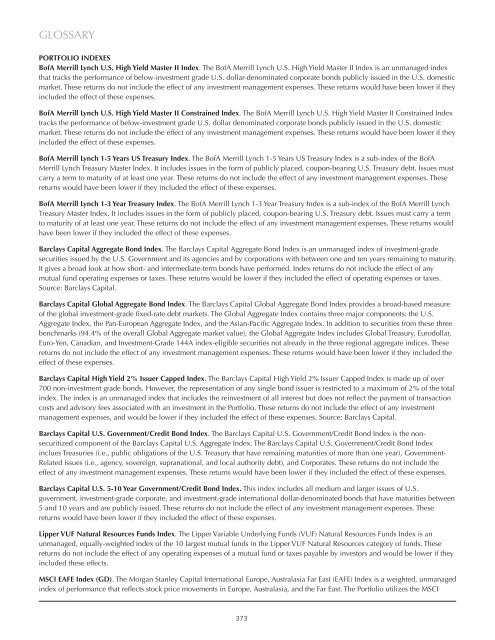Advanced Series Trust AST Academic Strategies Asset ... - Prudential
Advanced Series Trust AST Academic Strategies Asset ... - Prudential
Advanced Series Trust AST Academic Strategies Asset ... - Prudential
Create successful ePaper yourself
Turn your PDF publications into a flip-book with our unique Google optimized e-Paper software.
GLOSSARY<br />
PORTFOLIO INDEXES<br />
BofA Merrill Lynch U.S. High Yield Master II Index. The BofA Merrill Lynch U.S. High Yield Master II Index is an unmanaged index<br />
that tracks the performance of below-investment grade U.S. dollar-denominated corporate bonds publicly issued in the U.S. domestic<br />
market. These returns do not include the effect of any investment management expenses. These returns would have been lower if they<br />
included the effect of these expenses.<br />
BofA Merrill Lynch U.S. High Yield Master II Constrained Index. The BofA Merrill Lynch U.S. High Yield Master II Constrained Index<br />
tracks the performance of below-investment grade U.S. dollar denominated corporate bonds publicly issued in the U.S. domestic<br />
market. These returns do not include the effect of any investment management expenses. These returns would have been lower if they<br />
included the effect of these expenses.<br />
BofA Merrill Lynch 1-5 Years US Treasury Index. The BofA Merrill Lynch 1-5 Years US Treasury Index is a sub-index of the BofA<br />
Merrill Lynch Treasury Master Index. It includes issues in the form of publicly placed, coupon-bearing U.S. Treasury debt. Issues must<br />
carry a term to maturity of at least one year. These returns do not include the effect of any investment management expenses. These<br />
returns would have been lower if they included the effect of these expenses.<br />
BofA Merrill Lynch 1-3 Year Treasury Index. The BofA Merrill Lynch 1-3 Year Treasury Index is a sub-index of the BofA Merrill Lynch<br />
Treasury Master Index. It includes issues in the form of publicly placed, coupon-bearing U.S. Treasury debt. Issues must carry a term<br />
to maturity of at least one year. These returns do not include the effect of any investment management expenses. These returns would<br />
have been lower if they included the effect of these expenses.<br />
Barclays Capital Aggregate Bond Index. The Barclays Capital Aggregate Bond Index is an unmanaged index of investment-grade<br />
securities issued by the U.S. Government and its agencies and by corporations with between one and ten years remaining to maturity.<br />
It gives a broad look at how short- and intermediate-term bonds have performed. Index returns do not include the effect of any<br />
mutual fund operating expenses or taxes. These returns would be lower if they included the effect of operating expenses or taxes.<br />
Source: Barclays Capital.<br />
Barclays Capital Global Aggregate Bond Index. The Barclays Capital Global Aggregate Bond Index provides a broad-based measure<br />
of the global investment-grade fixed-rate debt markets. The Global Aggregate Index contains three major components: the U.S.<br />
Aggregate Index, the Pan-European Aggregate Index, and the Asian-Pacific Aggregate Index. In addition to securities from these three<br />
benchmarks (94.4% of the overall Global Aggregate market value), the Global Aggregate Index includes Global Treasury, Eurodollar,<br />
Euro-Yen, Canadian, and Investment-Grade 144A index-eligible securities not already in the three regional aggregate indices. These<br />
returns do not include the effect of any investment management expenses. These returns would have been lower if they included the<br />
effect of these expenses.<br />
Barclays Capital High Yield 2% Issuer Capped Index. The Barclays Capital High Yield 2% Issuer Capped Index is made up of over<br />
700 non-investment grade bonds. However, the representation of any single bond issuer is restricted to a maximum of 2% of the total<br />
index. The index is an unmanaged index that includes the reinvestment of all interest but does not reflect the payment of transaction<br />
costs and advisory fees associated with an investment in the Portfolio. These returns do not include the effect of any investment<br />
management expenses, and would be lower if they included the effect of these expenses. Source: Barclays Capital.<br />
Barclays Capital U.S. Government/Credit Bond Index. The Barclays Capital U.S. Government/Credit Bond Index is the nonsecuritized<br />
component of the Barclays Capital U.S. Aggregate Index. The Barclays Capital U.S. Government/Credit Bond Index<br />
inclues Treasuries (i.e., public obligations of the U.S. Treasury that have remaining maturities of more than one year), Government-<br />
Related issues (i.e., agency, sovereign, supranational, and local authority debt), and Corporates. These returns do not include the<br />
effect of any investment management expenses. These returns would have been lower if they included the effect of these expenses.<br />
Barclays Capital U.S. 5-10 Year Government/Credit Bond Index. This index includes all medium and larger issues of U.S.<br />
government, investment-grade corporate, and investment-grade international dollar-denominated bonds that have maturities between<br />
5 and 10 years and are publicly issued. These returns do not include the effect of any investment management expenses. These<br />
returns would have been lower if they included the effect of these expenses.<br />
Lipper VUF Natural Resources Funds Index. The Lipper Variable Underlying Funds (VUF) Natural Resources Funds Index is an<br />
unmanaged, equally-weighted index of the 10 largest mutual funds in the Lipper VUF Natural Resources category of funds. These<br />
returns do not include the effect of any operating expenses of a mutual fund or taxes payable by investors and would be lower if they<br />
included these effects.<br />
MSCI EAFE Index (GD). The Morgan Stanley Capital International Europe, Australasia Far East (EAFE) Index is a weighted, unmanaged<br />
index of performance that reflects stock price movements in Europe, Australasia, and the Far East. The Portfolio utilizes the MSCI<br />
373

















